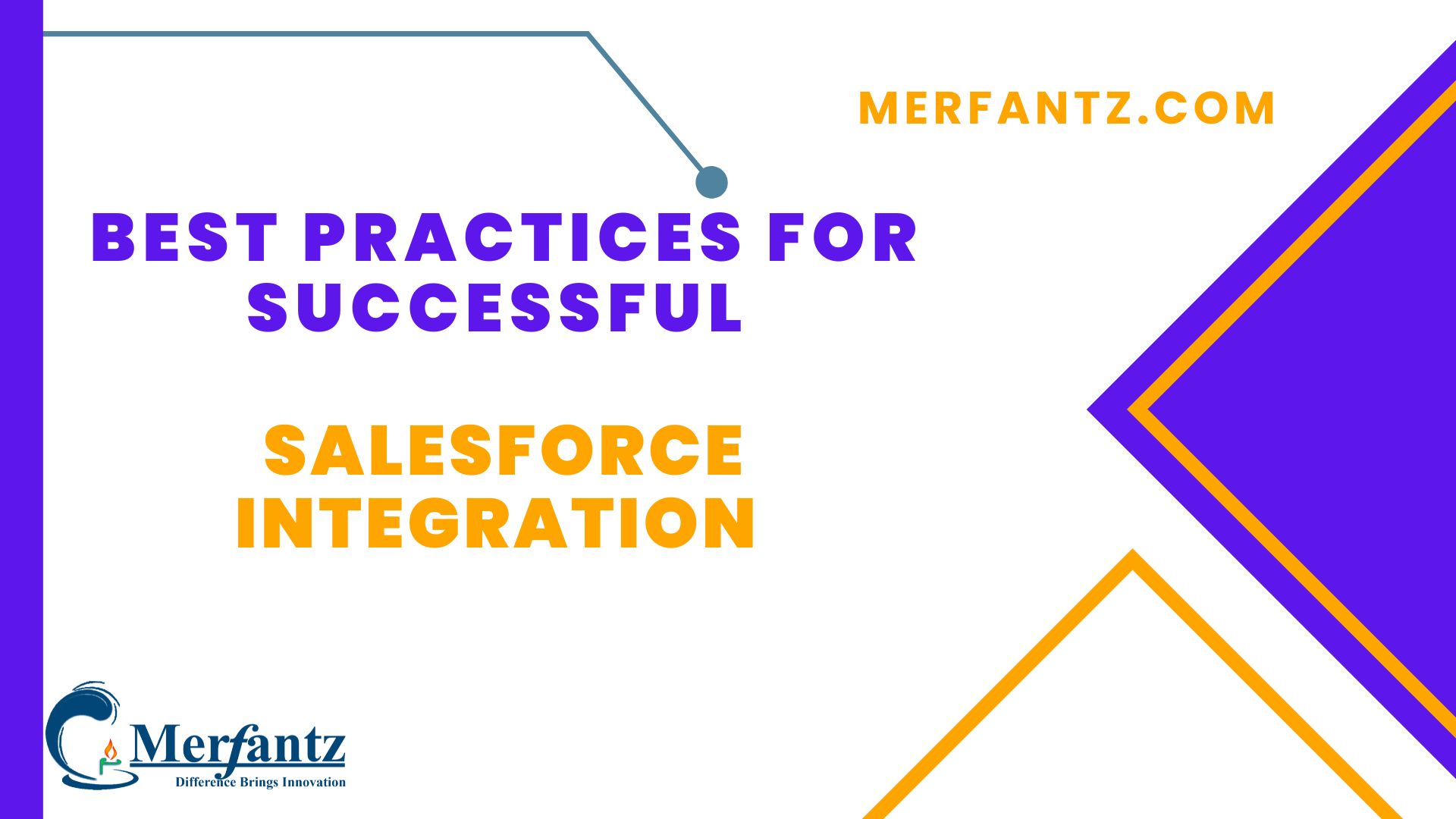Overview of Salesforce Integration
Salesforce integration plays a crucial role in enhancing business efficiency and streamlining workflows. By seamlessly connecting Salesforce with other applications and systems, organizations can achieve a unified view of their customer data, automate processes, and unlock valuable insights. At Merfantz Technologies, we understand the significance of Salesforce integration and offer comprehensive solutions tailored to meet your specific business needs. In this blog post, we will provide you with a detailed overview of Salesforce integration and how it can benefit your organization.
Salesforce integration involves integrating Salesforce with various systems, such as ERP, marketing automation, customer support, and more. This integration enables data synchronization, real-time updates, and a holistic view of customer interactions across different touchpoints. Whether you’re a small business or an enterprise, integrating Salesforce can empower your teams to work more efficiently, enhance customer experiences, and drive growth. In the following sections, we will explore the key benefits of Salesforce integration and the best practices to ensure a successful integration process.

Benefits of Salesforce Integration for Businesses
Integrating Salesforce with your business processes offers a multitude of benefits. Firstly, it allows for seamless data flow and eliminates manual data entry, reducing the risk of errors and ensuring data accuracy. With centralized and up-to-date customer information, your sales, marketing, and customer support teams can deliver personalized experiences and build stronger relationships with clients. Furthermore, Salesforce integration enables automation of repetitive tasks, saving time and boosting productivity across your organization.
Another significant advantage of Salesforce integration is the ability to harness actionable insights from data. By combining data from various sources, you can gain a comprehensive understanding of your customers’ behavior, preferences, and needs. This information empowers your teams to make data-driven decisions, optimize sales and marketing strategies, and drive revenue growth. Moreover, Salesforce integration facilitates efficient collaboration among teams, enabling seamless sharing of information and fostering a culture of transparency and alignment.
Key Considerations before Salesforce Integration
Before embarking on a Salesforce integration journey, it is essential to consider a few key factors. First and foremost, clearly define your integration objectives and identify the specific business processes that need to be streamlined. Understanding your integration requirements will help you choose the most suitable integration approach and ensure a smooth implementation. Additionally, assess your existing systems and applications to determine compatibility and identify any potential challenges that may arise during the integration process.
Furthermore, it is crucial to prioritize data security and compliance. Evaluate the sensitivity of the data being integrated and implement robust security measures to protect confidential information. Consider the scalability and future growth of your organization to ensure that the chosen integration solution can accommodate evolving needs. Lastly, involve all relevant stakeholders, including IT, sales, marketing, and customer support teams, in the planning process to gather valuable insights and ensure a successful integration strategy.
Choosing the Right Integration Approach
Selecting the appropriate integration approach is vital to the success of your Salesforce integration project. Two common approaches include point-to-point integration and using an integration platform. Point-to-point integration involves connecting Salesforce directly with individual applications, which can be suitable for simple integrations. However, as the number of integrations grows, managing and maintaining multiple connections can become complex and time-consuming. On the other hand, an integration platform, such as Merfantz Technologies’ Integration-as-a-Service, offers a centralized hub for managing all your integrations, providing scalability, flexibility, and ease of maintenance.
When choosing the integration approach, consider factors such as the complexity of your integration requirements, the number of systems involved, and the need for future scalability. An integration platform simplifies the integration process by offering pre-built connectors, data mapping tools, and workflow automation capabilities. It allows you to easily integrate Salesforce with various applications, customize workflows, and streamline data synchronization. By choosing the right integration approach, you can ensure a robust and future-proof integration solution for your organization.
Data Migration and Mapping Best Practices
Efficient data migration and mapping are crucial aspects of Salesforce integration. Start by thoroughly analyzing your data sources and defining a data migration strategy. Identify the necessary data fields to be migrated, ensure data integrity, and cleanse the data if required. Pay attention to data formats, data types, and data dependencies to avoid any discrepancies during the migration process. Additionally, establish clear data mapping rules to ensure that data is accurately transferred and synchronized between Salesforce and other systems.
Data mapping involves aligning the data fields between different applications to ensure seamless data integration. It is essential to establish consistent naming conventions and mapping guidelines to maintain data consistency and avoid data duplication or loss. Consider utilizing data transformation tools or services to handle any data format disparities or complex data mappings. Regularly validate and reconcile data during and after the migration process to ensure its accuracy and integrity. By following these best practices, you can ensure a successful and error-free data migration as part of your Salesforce integration.
Integrating Salesforce with Third-Party Applications
Integrating Salesforce with third-party applications expands the capabilities of your CRM system and allows for seamless data flow between different tools. Identify the key applications that complement your Salesforce implementation and enhance your business processes. These applications can include marketing automation platforms, ERP systems, customer support software, or any other tools that are essential to your operations. Integrating Salesforce with these applications enables you to centralize data, automate workflows, and provide a unified experience for your teams and customers.
When integrating Salesforce with third-party applications, consider utilizing pre-built connectors or APIs (Application Programming Interfaces) provided by the applications. These connectors facilitate easier and faster integration by establishing a standardized connection between the systems. Ensure that the integration supports bidirectional data synchronization, enabling real-time updates and maintaining data consistency across platforms. Thoroughly test the integration to verify the seamless flow of data and the accuracy of information shared between Salesforce and the third-party applications.
Ensuring Data Security during Integration
Data security is of utmost importance when integrating Salesforce with other systems. Protecting sensitive customer information, such as contact details, financial data, or personally identifiable information, is crucial to maintaining trust and compliance. Implement robust security measures, including encryption protocols, user access controls, and secure authentication mechanisms, to safeguard data during the integration process. Regularly monitor and audit the integration to identify and address any potential security vulnerabilities.
Consider leveraging Salesforce’s built-in security features, such as data encryption, field-level security, and IP restrictions, to enhance the security of your integration. Conduct thorough risk assessments and adopt industry best practices for data protection, following relevant regulations such as GDPR or HIPAA, depending on your business requirements. By prioritizing data security and implementing stringent measures, you can ensure the confidentiality, integrity, and availability of data throughout the Salesforce integration.
Automation and Workflow Optimization with Salesforce Integration
One of the significant benefits of Salesforce integration is the ability to automate processes and optimize workflows. Identify repetitive manual tasks, such as data entry, lead assignment, or report generation, and automate them through the integration. Streamlining these workflows improves efficiency, reduces errors, and allows your teams to focus on more strategic activities. Leverage Salesforce’s automation tools, such as process builders, workflow rules, or Apex triggers, to create customized automation that aligns with your unique business requirements.
With Salesforce integration, you can establish seamless data flows and triggers between systems, enabling automated notifications, updates, or actions based on specific events or conditions. For example, integrating Salesforce with your marketing automation platform can automate lead nurturing campaigns or trigger personalized email sequences. Explore the possibilities of workflow optimization with Salesforce integration to streamline your business processes, enhance collaboration, and drive productivity.
Common Challenges in Salesforce Integration
While Salesforce integration offers numerous benefits, it’s important to be aware of common challenges that can arise during the integration process. One challenge is data inconsistency or duplication, which can occur when integrating data from multiple sources. It’s crucial to establish data governance practices and implement data validation and de-duplication mechanisms to maintain data integrity. Another challenge is system compatibility, as different applications may have varying data formats, APIs, or integration capabilities. Thoroughly assess system compatibility and consider utilizing middleware or integration platforms to address compatibility issues.
Integration complexity is another challenge that organizations may face. As the number of integrated systems and processes grows, the complexity of managing and maintaining the integration also increases. It’s essential to design a scalable integration architecture and adopt best practices for system monitoring, error handling, and performance optimization. Additionally, ensure proper documentation of the integration process and provide comprehensive training to users to mitigate any usability challenges. By understanding and addressing these common challenges, you can navigate the Salesforce integration journey more effectively.
Conclusion:
In conclusion, Salesforce integration is a powerful tool that can revolutionize your business processes, improve data accuracy, enhance collaboration, and drive growth. By following best practices, such as considering key considerations, choosing the right integration approach, and implementing data migration and mapping best practices, you can ensure a successful integration journey. Additionally, prioritize data security, leverage automation, and be prepared to address common challenges that may arise. At Merfantz Technologies, we specialize in Salesforce integration and can assist you in maximizing the benefits of integrating Salesforce with your business systems. Contact us today to explore how we can help you achieve a seamless and efficient Salesforce integration.
FAQ:
1. What is Salesforce integration?
Salesforce integration refers to the process of connecting Salesforce with other applications, systems, or databases to enable seamless data sharing, automation, and collaboration. It allows for a unified view of customer data, streamlines workflows, and enhances business efficiency.
2. Why is Salesforce integration important for businesses?
Salesforce integration is essential for businesses as it enables the consolidation of data from various sources, enhances customer experiences through personalized interactions, and automates repetitive tasks. It facilitates efficient collaboration among teams and provides actionable insights for data-driven decision-making.
3. What are the benefits of Salesforce integration?
The benefits of Salesforce integration include improved data accuracy, streamlined processes, enhanced productivity, personalized customer experiences, optimized sales and marketing strategies, and increased efficiency through automation. It also enables better collaboration and provides a holistic view of customer interactions.
4. What are the key considerations before implementing Salesforce integration?
Before implementing Salesforce integration, it’s important to clearly define integration objectives, assess compatibility with existing systems, prioritize data security, evaluate scalability requirements, involve relevant stakeholders, and choose the right integration approach based on the complexity of integration needs.
5. How can Merfantz Technologies assist with Salesforce integration?
Merfantz Technologies specializes in Salesforce integration and provides comprehensive solutions tailored to meet your specific business requirements. Our team of experts can guide you through the integration process, from planning and implementation to data migration, mapping, and system compatibility. We ensure a seamless and successful Salesforce integration that maximizes your business efficiency.
6. What are the common challenges in Salesforce integration?
Common challenges in Salesforce integration include data inconsistency or duplication, system compatibility issues, integration complexity, and usability challenges. However, with proper planning, best practices, and the support of an experienced partner like Merfantz Technologies, these challenges can be effectively addressed.
7. How long does Salesforce integration typically take?
The duration of Salesforce integration can vary depending on factors such as the complexity of integration requirements, the number of systems involved, and the data volume to be migrated. A well-planned integration process can typically range from a few weeks to a few months, considering the analysis, configuration, testing, and deployment stages.
8. Is data security ensured during Salesforce integration?
Yes, data security is a critical aspect of Salesforce integration. Merfantz Technologies follows industry best practices to ensure the confidentiality, integrity, and availability of data during the integration process. We implement robust security measures, including encryption protocols, user access controls, and secure authentication mechanisms, to safeguard sensitive information.
9. Can Salesforce be integrated with third-party applications?
Yes, Salesforce can be integrated with a wide range of third-party applications, such as marketing automation platforms, ERP systems, customer support software, and more. Integration enables seamless data flow, process automation, and enhanced collaboration between Salesforce and these applications, providing a unified experience for your teams and customers.
10. How can I get started with Salesforce integration with Merfantz Technologies?
To get started with Salesforce integration, simply Contact Merfantz Technologies through our website or reach out to our sales team. We will schedule a consultation to understand your integration requirements and provide you with tailored solutions and a roadmap for a successful Salesforce integration journey.
Author Bio
Co-Founder & CMO at Merfantz Technologies Pvt Ltd | Marketing Manager for FieldAx Field Service Software | Salesforce All-Star Ranger and Community Contributor | Salesforce Content Creation for Knowledge Sharing





